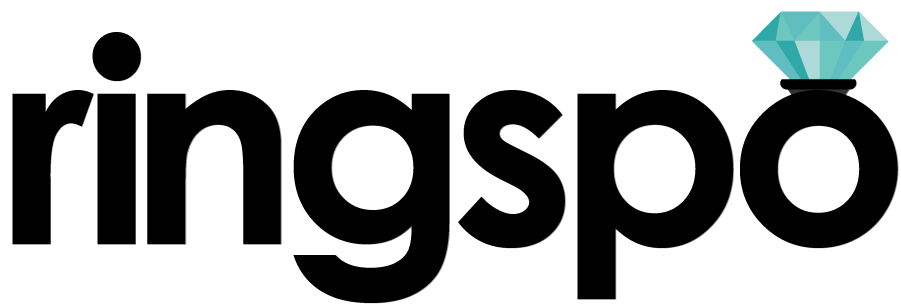Vintage engagement rings
The three types of antique rings you need to know about
Ringspo is reader supported
Ringspo is reader-supported, which means we may receive a commission if you click a link to a retailer & subsequently make a purchase.
We feature links to several retailers to help readers find the one that is the best fit for them. Find out more about how Ringspo works here.
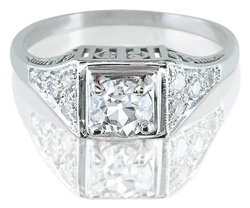
You might be looking for a vintage engagement ring to match your girlfriend’s style, or just because you know that’s what she’s always wanted. But what does ‘vintage’ really mean and how do you make sure you get a great ring without being ripped off?
Vintage engagement rings are increasingly popular for a whole host of reasons. For women with a bit of retro style, a brand spanking new bit of finger bling from a jeweller often won’t fit in with their taste in jewellery, clothes or even their world view.
Vintage rings are often less expensive than brand new rings and it can be argued that they’re more ecologically sound, as no recent mining was conducted to produce them.
Some people also like the idea that vintage rings have a story behind them and they often have more character than a new ring. Minor imperfections that they have picked up over the last 50 years of use add to the story and the charm of the ring.
Vintage rings are also more likely to be unique – they would have been handmade by an artisan craftsman over 50 years ago, rather than cut by a robot with a frickin’ laser beam like modern rings. Often the level of craftsmanship of vintage rings would be extremely difficult and expensive to replicate today, sothe level of quality that you can obtain can be out of reach for a new ring.
Finally, they’re classic and timeless, meaning that they will never go out of fashion. While modern engagement rings follow definite trends (round cut brilliant solitaire diamond rings make up a huge percentage of new engagement rings sold at the moment), a vintage ring will always be stylish.
So, there are a lot of great reasons why a vintage engagement ring makes sense. But, there are a lot of choices out there and it can all seem a little overwhelming. In this post, I’m going to talk you through the different types of antique ring available, give you some tips on where to find the best ones and help you out with some pointers on what to look for.
Types of vintage ring
Most vintage rings will be over 50 years old, and they are easily categorised into three buckets, depending on when they were made. As with today, there were definite fashions for engagement rings during these periods, so it makes it easy to classify them and identify when an antique ring was made.
Victorian Engagement Rings: 1835 – 1901
Victorian rings are rare to find because they were made so long ago, but you should be able to find them in specialist antique jewellers. They are usually very intricate and decorative, with engravings of scrolls etc.
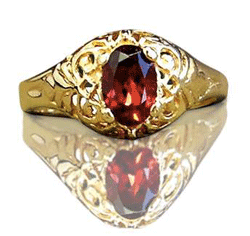
They often have a large central stone supported by several smaller stones, a bit like a modern halo setting.
Diamonds were not as common then as they are today, so other stones were commonly used, like sapphires, rubies, emeralds, and pearls. All of these stones are much less hard than diamonds, so when looking at a ring that is well over 100 years old, you really need to do it in person, to ensure that there is no damage to these softer stones.
Yellow gold and rose gold were the most popular metals for the bands, as these were Queen Victoria’s favourite and her taste was hugely influential.
One thing you should know is that gold engagement rings from early in the period may not have a stamp on them to show what type of gold has been used on the band. This was only required from 1854 onwards when the ‘Stamp Act’ was introduced, which meant that jewellers were then required to include whether jewellery was 9 carat gold, 18 carat gold etc. To learn more about the difference between the types of gold, check out this post.
Edwardian Engagement Rings: Early 1900s
Edwardian engagement rings are very ornate, with jewellers aiming to make the ring setting look like folded lace.

Bending metal like this is known as ‘filigree’ and was only made possible after the oxyacetylene torch was invented and platinum could be heated up to extremely high temperatures. So, Mr oxyacetylene-torch inventor – future vintage ring wearers and Flashdance viewers alike salute you!
People were keen to embrace the possibilities that this offered and many Edwardian engagement rings are platinum, which is good because it holds up so well to use. An additional decoration that you might see is the placement of small beads of metal in a decorative pattern, which is known as ‘millgraining’.
Stone-wise, diamonds, particularly in the ‘rose cut’ were popular for use in Edwardian engagement rings, but it was before diamonds were widely available, so often less expensive stones were used. Sapphires, black opals and aquamarines were popular choices for the centre stone.
Edwardian engagement rings often have the best craftsmanship out of any antique rings, and should have stood the test of time well.
Art Deco Engagement Rings: 1920s – 1940s
Probably the most popular type of vintage ring are those from the art deco period. Art deco is a broad term, but it basically describes a particular style of visual design that was applied to a huge range of things from1920s until just after WWII – from buildings to cars, paintings to jewellery
Although there are no hard and fast rules on what makes something art deco, there are some principles that art deco design stick to.
While rings Edwardian engagement rings were decorative, swirly and ultra-feminine, art deco is all about strong geometric shapes and symmetry.
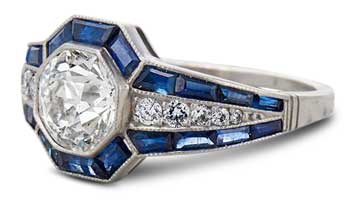
This ties in to the modernisation that was happening around the world at the time – Henry Ford was just starting to crank out Model Ts, air travel was just beginning, and manufacturing equipment was getting more sophisticated – allowing jewellers to do much more than they were previously able to.
Common cuts for stones include the ‘French cut’, which is a basic square cut, and the newly introduced ‘trillion’, which is a triangle cut which has now largely fallen out of fashion. You will often find that stones with contrasting colors have been used – usually sapphires or emeralds contrasting against a white diamond.
One thing that did remain consistent from the Edwardian era was the use of platinum. Although gold and sometimes silver were used, it was the ultra modern platinum that was favoured by those who could afford it for art deco engagement rings.
Watch outs
Durability
Vintage engagement rings may have stood the test of time so far, but durability is definitely something that you need to consider.
When it comes to the setting, delicate and flowery designs from the Victorian and Edwardian periods may need to be looked after, while art deco design usually use more metal so should be a little sturdier.
Diamonds are a common engagement ring stone for many reasons, but a big factor in their suitability for a ring that is going to be worn every day is their durability – they are extremely hard and won’t get scratched or chipped. Many vintage rings use other stones which were easier to obtain at the time they were made. However, these stones often need to be looked after much more carefully than diamonds. Pearls, in particular, are extremely soft and not suitable for day to day wear.
Use
Related to durability is how the ring is going to be used. Even delicate rings with ‘soft’ stones can make great choices for engagement rings if the wearer isn’t going to wear it every day and is careful about taking it off while they do anything strenuous.
Centre stones
Today, most stones are cut by laser to maximise the amount of light they reflect back to our eyes and to minimise the appearance of any flaws. In days of yore though, this obviously wasn’t possible, so antique engagement rings’ centre stones often won’t sparkle quite as brightly as a modern rock. Not necessarily a bad thing, the hand-made nature of the cut can make the ring more unique.
A further difference between vintage stones and modern stones can be the colour of the central diamond, which can also add to their charm. While today, colourless white diamonds are the most prized, in older rings there you are more likely to mind more yellow, or eve rose-tinted diamonds, as these were fashionable at the time.
It’s important not to get too caught up in the stats of the 4Cs with vintage rings, like people do with brand new rings. Instead it’s more about finding a ring that you, or your other half, loves the look of.
Repairs
When looking at vintage engagement rings, always ask the jeweller if any repairs have needed to be made to the ring, and make sure that this work is up to the standard of the original manufacture.
If a stone has needed to be replaced in the past because the original fell out, you’ll want to make sure that the repair has ensured that this won’t happen again in the future.
It’s also worth thoroughly checking any ring to make sure that none of the stones are currently loose.
Matching with wedding rings
Many vintage engagement rings, particularly art deco rings, are much larger than modern rings and take up more space on a finger. Because of this, it can be difficult to wear both an vintage ring and a wedding ring on the same finger.
To get around this, some people have a custom-bent wedding band made, to fit the contours of the engagement ring. An alternative is simply to wear the engagement ring on the right hand, and the wedding ring on the left, or just to retain the engagement ring as the stand-alone ring on the left hand.
Size
When buying a new ring, you can specify the size and get it as close as possible to your intended’s finger size. If it’s just a little out, it’s not a big deal to resize is a couple of sizes, although it’s always easier to go down in size than up.
With vintage rings, you are still able to resize the ring, but you’ll be working from a fixed point – the size of the previous owner’s finger. Again, you can resize it one or two sizes quite easily, but any more than this and it will start to get expensive and could possibly affect the structural integrity of the ring.
Appraisal
An appraisal is an assessment of a piece of jewellery by an independent expert, who will ensure that it is what it is meant to be and will also rate its value.
Appraisals and certification are an essential part of buying any engagement ring, but even more important when buying an antique engagement ring, where the history and provenance of the ring are unknown.
An appraisal will reassure you that the ruby ring that you are just about to fork over hundreds of dollars for is indeed a ruby and not just coloured glass costume jewellery.
When conducting an appraisal on a vintage engagement ring, the appraiser will examine the ring through a microscope and define:
- Approximate date and place of manufacture
- Whether it’s a real or fake gemstone
- Weight and quality of stones
- Whether it’s a real or fake gemstone
- Manufacturer information
- Value (important for insurance purposes)
If a ring doesn’t have an appraisal certificate before you purchase, you should have an independent appraisal conducted after you buy it to reassure yourself that you have got the real deal and to ensure that the ring is insured for the correct amount.
Return Policy
Appraisals bring us neatly onto return policies. Ensure that the retailer offers a return policy that satisfies you. A couple of reasons that you may need to return it are if the ring isn’t genuinely what you thought it was, or if the ring cannot be resized to fit. Note that if you have already had a ring resized, it’s unlikely that a store will accept it back.
Where should you buy from?
As with all engagement rings, your choice is basically whether to look in bricks and mortar stores or online.
Bricks and mortar
For vintage engagement rings, bricks and mortar stores will give you the opportunity to see the actual ring that you’re going to purchase and, if you’re shopping with your other half, for her to try it on her finger before you take the plunge and buy. This is especially important for vintage stones because the cut and colour of the rocks will be unique, so it’s good to be able to check that you are happy with them.
The best bricks and mortar stores to try are antique stores, or specialist vintage jewellers, although these may be few and far between in your area. I would avoid trying your luck at pawn shops or at estate sales unless there is certification provided with the ring – otherwise you can never be quite sure that you’re getting what you pay for and the returns process is likely to be more difficult.
Online
Online, you have a choice of either purchasing from a dedicated retailer or alternatively from an online marketplace like eBay or Etsy.
Ebay may seem like a gamble, but there are dedicated sellers on there who have built up a reputation for selling genuine and high quality rings over a period of years. I would only consider buying from those sellers with a large number of positive feedback marks, rather than individuals selling just one ring. They will usually provide a complete description of the ring, with the age, condition etc included and possibly a certification too. Ebay also offers a solid buyer protection policy where they will mediate any disputes if there are any issues.
The alternative is buying from an online retailer that specialises in vintage jewellery. Again, only purchase from businesses that appear well-established and reputable and ensure that they have an acceptable return policy in case the ring isn’t all that you hoped it would be.
A final alternative is to choose a retailer that offers replica vintage engagement rings. As well as the guarantee that the stone that you are buying is definitely real and definitely high quality, you’ll also benefit from high quality workmanship, a great returns policy and a sparklier modern-cut diamond.
My recommendation
If you like the look of a vintage ring, but aren’t keen on the issues we highlighted, you could opt for a reproduction ring. A reproduction ring is a modern ring fabricated to emulate the style of Edwardian ring, with modern levels of materials and craftsmanship.
My recommendation here is Taylor & Hart, who produce incredibly beautiful rings and deliver a wonderfully collaborative experience.
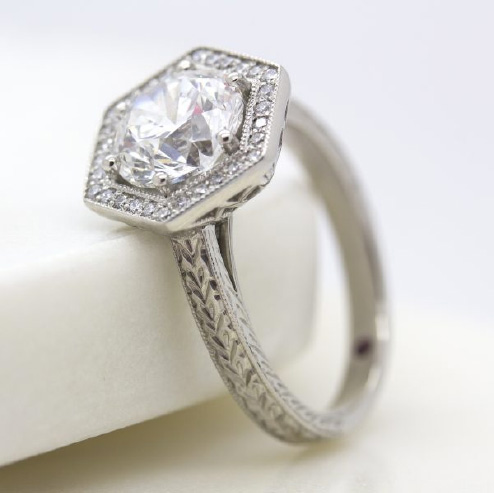
They will listen to your ideas, give you guidance, deliver incredible workmanship and stand behind their product with a level of service and value that you will rarely find in any arena.
Click below to check them out and I’d recommend talking to them on their livechat to see whether they can help bring your dream vintage ring to life.
